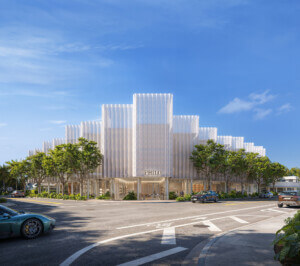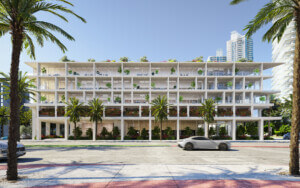Senior living as a building typology is relatively new. At the beginning of the 20th century, the care of seniors typically fell to families. “Indigent” seniors were relegated to a system of “poor houses or poor farms,” according to a 2020 myLifeSite interview with Dr. Keren Wilson, the gerontologist often credited with starting the first “assisted living” facility in 1981. With the launch of Medicare and Medicaid in 1965, many poor houses transitioned into the first nursing homes. Drab, institutional, and deeply sad, these facilities set the template for senior care in the second half of the century and cemented a stigma that remains to this day.
As an architect focused on senior living, my mission is to undermine this stigma. Together with my colleagues at LEO A DALY, I practice what we’ve come to call Dignity Driven Design. With every project, we seek to enhance the self-worth, quality of life, and wellbeing of seniors and their social circles. We do this by creating environments that support social vibrancy, cultural connection, intergenerational gathering, independence, wellness, cognitive health, and longevity while offering appropriate support through every stage of aging.
While most seniors would prefer to age in place—that is, to remain in their established lifestyle for as long as possible—many homes and communities are just not built to enable people of all ability levels to live safely, independently, and comfortably. The disparity common between a senior’s environment and their ability level is known as “environmental press,” and its result, according to gerontologist Esther Greenhouse in Planning magazine, is the phenomenon of “forced frailty.” In navigating or avoiding an ableist-built environment, a person will artificially lower their level of functioning, often leading to isolation and premature physical and cognitive decline.
Continuing Care Retirement Communities (CCRCs) fill a need for seniors whose current environment is unsuited to aging in place. Offering a continuum of support that includes independent living, assisted living, memory care, and skilled nursing, seniors can stay independent longer while enjoying a full, meaningful, connected, and dignified life. In this article, I’ll share some of the principles behind Dignity Driven Design, along with examples of recent LEO A DALY CCRC projects that do it well.
Create community
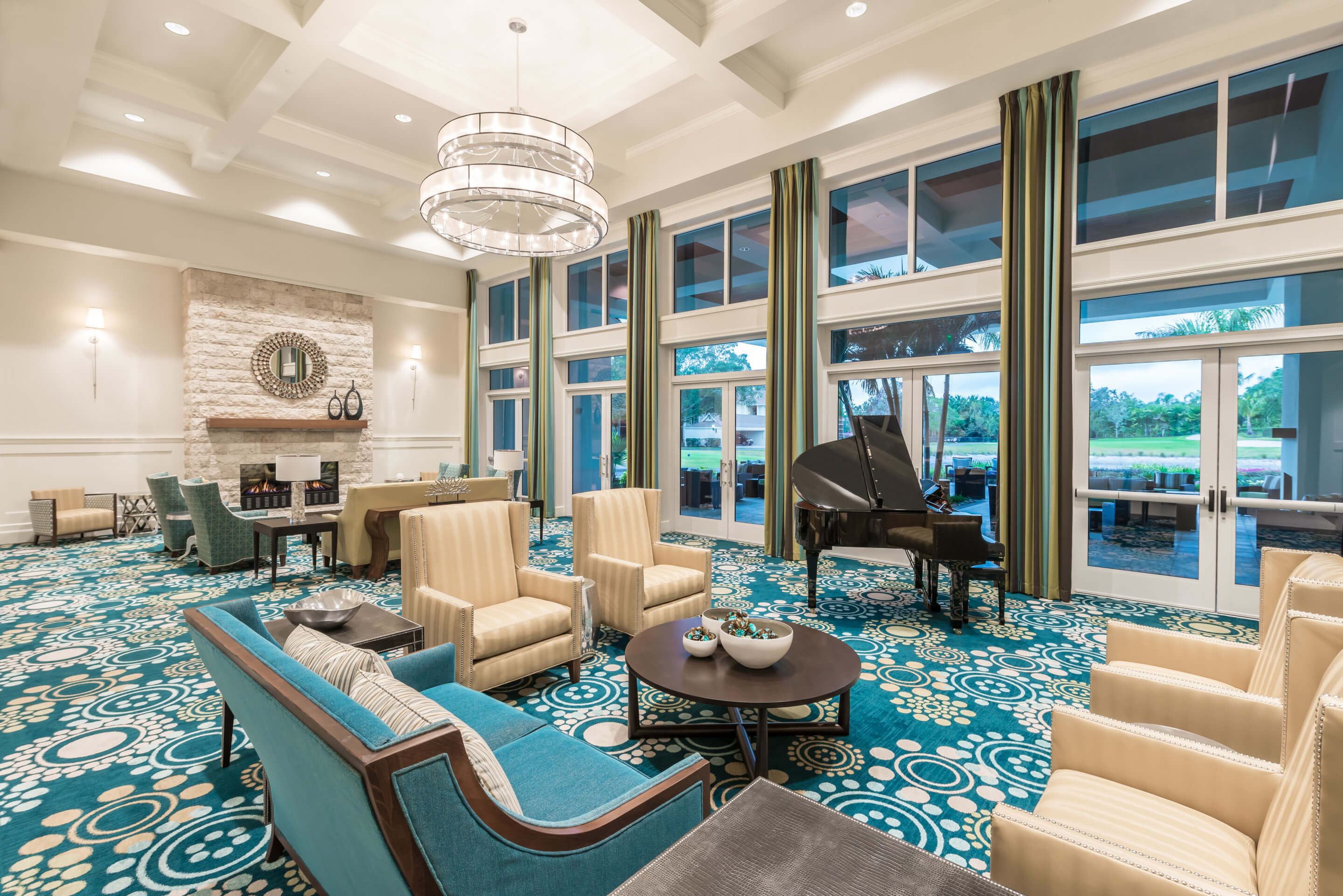
A community can be reduced to the sum of the interpersonal connections between the people in it. In Dignity Driven Design, every design element becomes a part of the supportive framework that enables residents to connect with others and build meaningful experiences.
Vi Living at Bentley Village (Naples, Florida) takes cues from country clubs and luxury Caribbean resorts to create a catalyst for social life. The East Club House anchors a 72-unit tower and serves as the community’s main hub. Connectivity is enabled at a variety of scales, with a grand entry and lobby; formal, casual, and private dining areas; game and billiard rooms; an arts and crafts rooms; two bars; a library; a golf shop, and a multipurpose room that comfortably seats 500 residents.
The West Club House is centered around self-care, with a pool, fitness and aerobics center, spa, and salon. Poolside dining from a full-service restaurant connects indoor and outdoor, and a fire pit creates a visual anchor and meeting spot. Bold aqua and coral coloring, wood-slatted ceilings and dramatic lighting create an elegant atmosphere for fun and friendship.
Celebrate culture
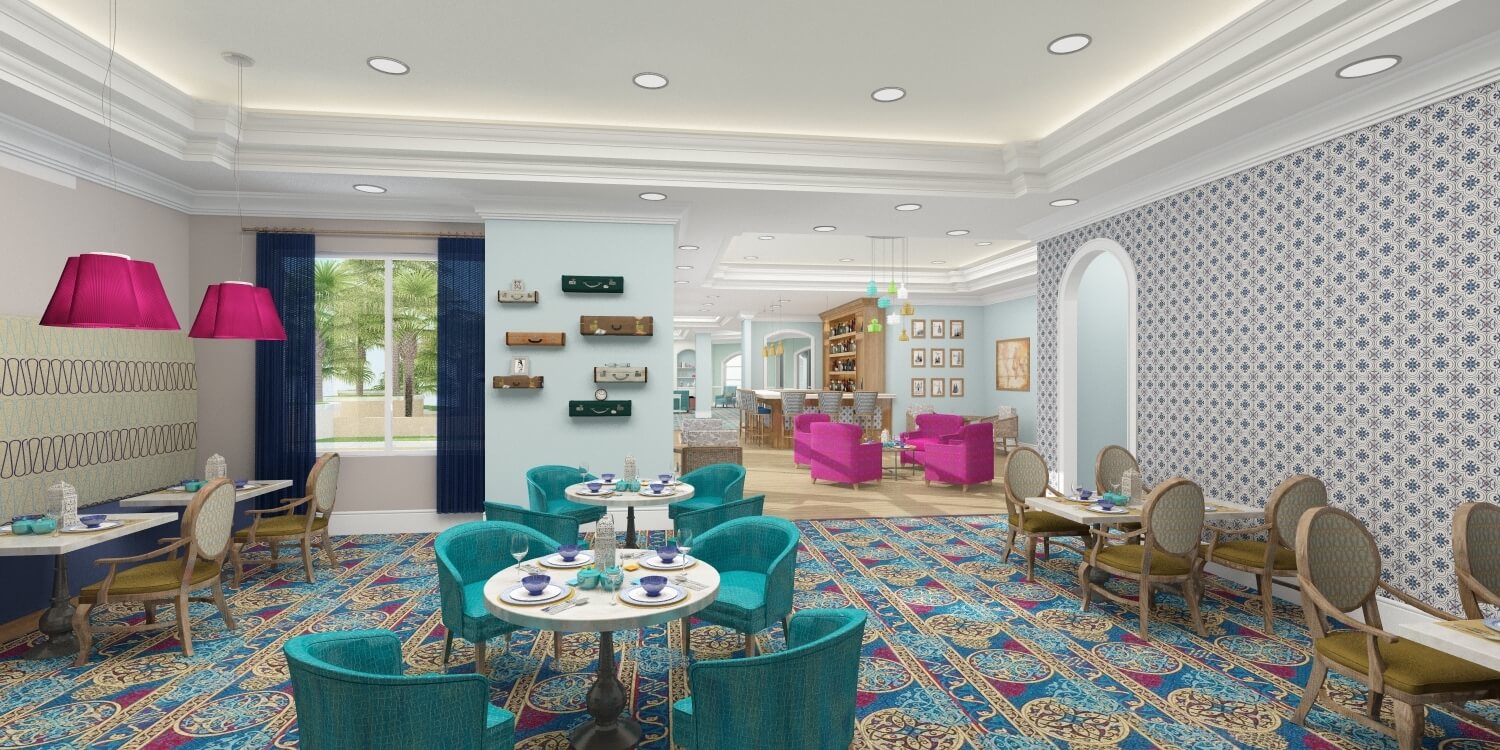
Many people view seniors as a monolithic group. Dignity Driven Design recognizes that residents are individuals with diverse backgrounds and compelling life stories.
Vi Living at Aventura (Miami, Florida) celebrates the cultural mix of its residents. Catering to a South Florida population with familial and personal connections throughout the world, the interior design creates a multi-cultural destination inspired by international travel. An aquatic palette serves as a backdrop to rich colors, bold patterns, and textiles from many cultures. The theme of travel is furthered with installations of vintage suitcases, Japanese vases, mirrors reminiscent of the lotus flower, and other artifacts that suggest the curio collection of a world citizen.
Create intergenerational space
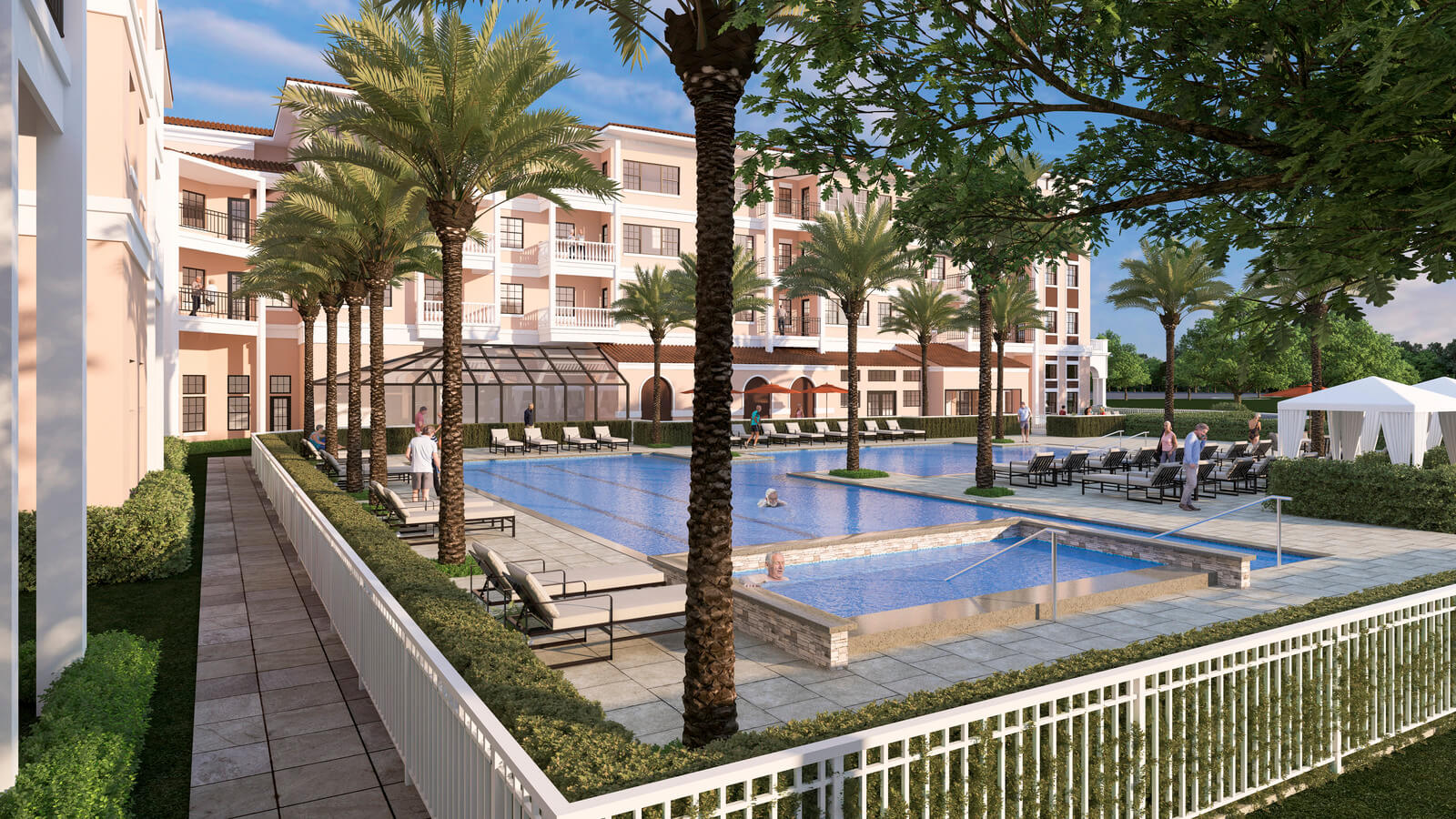
Before moving into a CCRC, many residents fear being cut off from their families and social circles. Dignity Driven Design creates amenities intended to entice, welcome, and entertain guests of all ages, group sizes and interests.
Sinai Residences (Boca Raton, Florida) was designed as a great place to invite guests. The 4-story independent living building, now under construction, offers 111 luxury apartments ranging from 900-to-3,200 square feet. While residents typically live alone or in pairs, these units are strategically sized and outfitted to enable large gatherings of family and friends. The theme of “entertaining” carries through the public spaces, which include two restaurants, a movie theater, a board room, and a resort-style pool with outdoor bar, tensile shade structures and private cabanas.
Fit the environment to the ability level
The opposite of environmental press, according to Greenhouse, is environmental fit. As some residents age, they will require additional support in overcoming cognitive challenges. Dignity Driven Design aims to create memory care environments that make activities of daily life easier and more intuitive, resulting in residents who feel more comfortable, capable, and engaged.
YourLife’s prototype memory care community, which has been replicated in Tallahassee, Stuart, Coconut Creek, and Wildwood, Florida, provides the perfect environmental fit for cognitively impaired residents. Each community is one building, comprised of four “neighborhoods,” each positioned around a central courtyard. This arrangement provides needed security and safety for residents while offering access to outdoor activities. The easy-to-navigate organization creates comfort and familiarity as residents learn their routine and get to know their neighbors. Each private unit (there are 15 to 25 per neighborhood) features a private bath designed to orient residents and cue hygiene. Built-in cabinets use open display “cubby” housing to cue daily dressing. Oversized windows assist with temporal orientation, while specialized covered lighting eliminates contrast and shadows on the floor surface to reduce visual confusion.
Encourage play
For memory care residents, play is occupational therapy. Dignity Driven Design is committed to helping residents retain physical fitness, coordination, and cognitive skill for as long as possible.
YourLife’s prototype memory care communities are full of activity areas geared at play. Baby doll changing stations, stuffed animals, toy tool benches, and internal mailboxes provide opportunities for residents to activate muscle memory, build dexterity, and exercise creativity. Outdoor amenities, shared among the four neighborhoods, include green spaces, strolling paths, decorative benches, putting greens, raised planters for gardening, and grilling areas. Utilizing these activity centers together with visiting guests adds a fun, meaningful aspect to their time together.
Enable independence through scaffolding
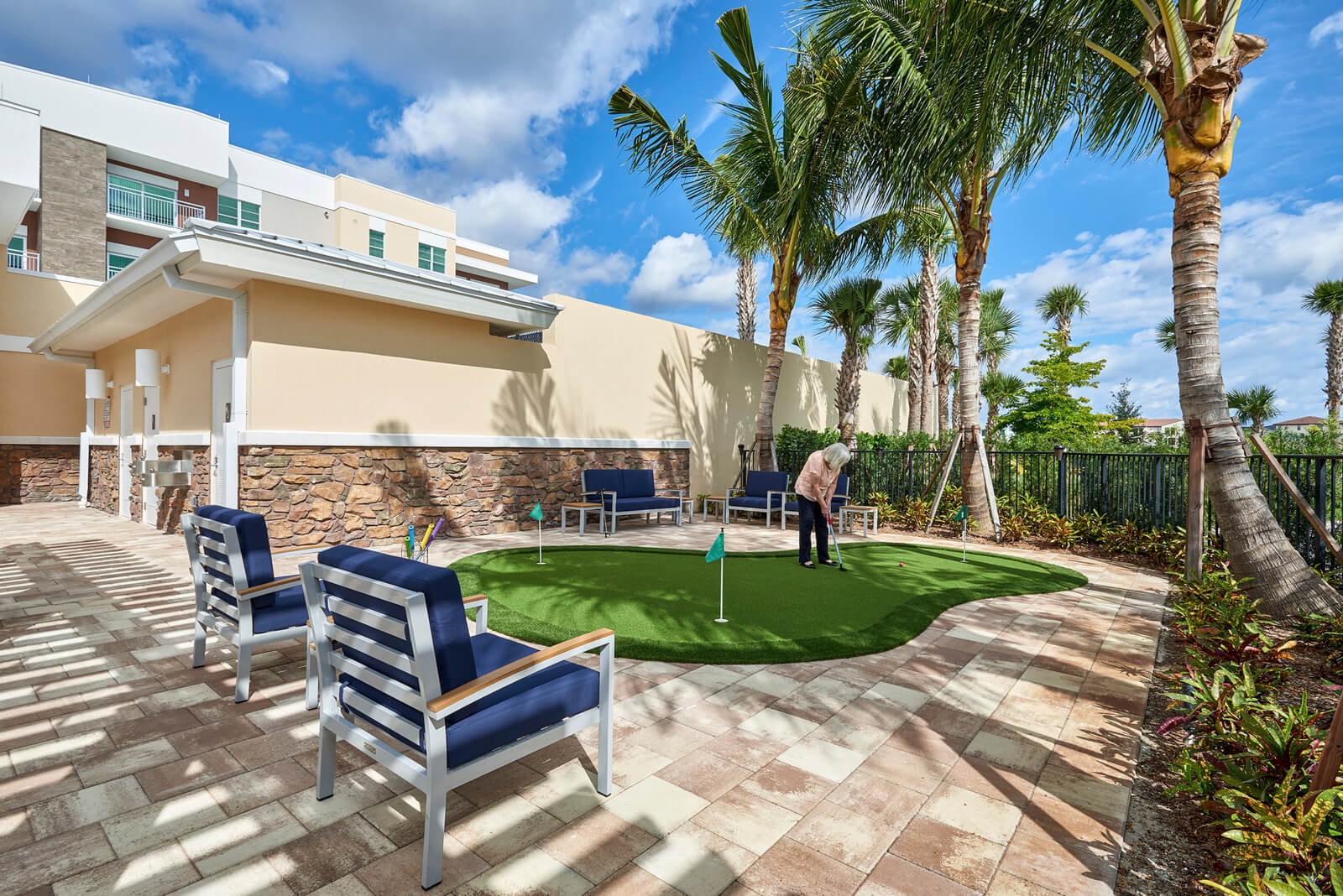
Gradually losing independence is one of the most difficult parts of aging. Dignity Driven Design seeks to provide an invisible layer of scaffolding to prevent injury and support “one more day” of independence for residents.
YourLife of Palm Beach Gardens (Palm Beach Gardens, Florida) scaffolds mobility for assisted living residents by using a very simple design solution. In each assisted living suite, a vertical strip of LEDs glows next to the restroom door. The warm, yellow light does not impact sleep, but it will help a disoriented resident sense which way is up during midnight trips to the restroom. This is just one example of many design elements that reinforce safety and enable residents to stay as independent as possible for as long as possible.
Dignity’s the thing
Seniors across the spectrum of aging share the need for a meaningful, active, and dignified life, whether aging in place or living in a purpose-built community. Dignity Driven Design helps residents maintain a proper match between environment and ability level through every stage. Although it comes packaged differently in independent living, assisted living, memory care and skilled nursing, the foundation is the same: seniors deserve dignity.
Michael Rodebaugh, AIA, NCARB, leads the senior living practice of global planning, architecture, engineering, and interior design firm LEO A DALY. His mission is to elevate the lives of senior living residents through Dignity Driven Design. He excels in creating inviting spaces that encourage multigenerational interactions between residents, visitors, and staff. Rodebaugh extends this passion and knowledge to the full continuum of care environments, including independent living, assisted living, and memory care.









